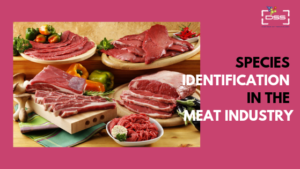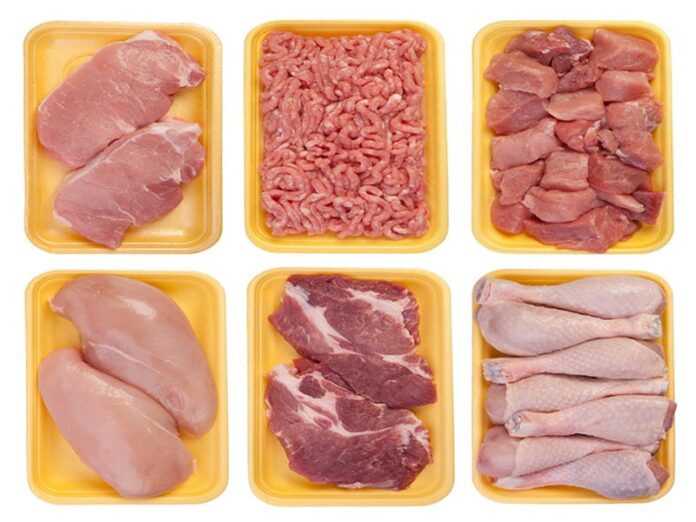TOOLS FOR IDENTIFICATION OF MEAT OF DIFFERENT SPECIES & SEX OF ANIMALS
Adulteration of higher quality meat with cheaper or inferior quality meat is prevalent in the meat industry. Identification of meat from closely related meat species based on morphological features of meat is very difficult and it becomes even worse if meat is cooked or processed. Substitution of meat and meat products has always been a concern for various reasons such as wholesomeness, religious factors, public health and unhealthy competition in meat market (Arslan et al., 2006). Proper labelling of meat and meat product is necessary to avoid fraudulent replacement of superior commercially valuable meat by cheaper or inferior meat of alternative species or replacement of animal protein with plant proteins (Ballin et al., 2009). Consumers are conscious about the source of food and expect it to be authentic. Thus, meat differentiation had become a significant element in food quality control procedures (Kumar et al., 2014). Morphological character based identification is practiced to identify different species. However, when the time animal has been slaughtered for food, these markers are often removed from animal intentionally or destroyed. This creates problem for different government agencies who are involved in identification of species origin of an animal or products in order to enforce health related and or conservation regulations. The problem becomes more complicated if the meat of that animal has been processed (Bartlett and Davidson, 1992). Different techniques were followed for meat species detection which are based on morphological characters, protein based like electrophoresis techniques, spectrophotometry techniques and DNA based techniques like polymerase chain reaction. Techniques based on DNA is more advantageous over protein based techniques due to the fact that protein expression is tissue specific in nature and different processing and heating conditions of meat results in denaturation of proteins. DNA is more thermostable and less susceptible to disruption during different types of processing condition and furthermore, DNA is present in almost all cells. So, information getting from DNA by appropriate samples from same source will be identical regardless of the tissue of origin (Lockley et al., 2000). Mitochondrial DNA consists of sequences like D-loop region (Kumar et al., 2011 and Mane et al., 2011), mitochondrial RNA genes i.e. 18s, 16s and 12s (Mane et al., 2012; Girish et al., 2004 and Chen et al., 2010) and cyt-b genes (Hertanto et al., 2017 and Sari et al., 2017) which are commonly used as target sites for species detection in DNA based techniques. Mitochondrial cyt-b gene is one among most extensively sequenced genes and due to its sequence variability, this region of mitochondrial DNA is used to study the phylogenetic relationship among different organisms (Johns et al., 1998). Since DNA sequence analysis was costly PCRRFLP technique is used as a routine analytical tool for species testing (Partis et al., 2000.
Meats from different species of animals are very important to be identified for their taste and quality for which consumer pay. Freshness, bloom, colour, flavour, tenderness of meat in each species of animals are different. Meat can be identified depending upon the colour, marbling, texture, flavour and tenderness etc. ~dulkration of meat involves substitution of costly or superior quality with cheaper, undesirable or inferior quality meat. Substitution of meat can be detected to check fraudulent practice of replacing beef for buffalo meat; sheep for goat meat; buffalo veal for mutton and so on. Substitution can be identified carefully in raw meat and also in cooked meat. The sensory methods of identifications also can be done by trained panelist. There are various physical, chemical, anatomical, histological, and serologicaVirnrnunological methods for identification meats. Here you will learn to identify the meats depending upon different physical methods.
Meat adulteration, substitution in ground or comminuted products has been a widespread problem and the detection of meat species is needed due to various reasons including health, religion and economy. The meat speciation is also important for the implementation of national standards as well as to protect the consumer interest. In India, inspite of ban, cows and bullocks are occasionally slaughtered. Many endangered or critical species of wild animals and birds are hunted for food or some aesthetic purposes. Administrative authorities and quality control officials in most of the states often face the problem of meat speciation. At present only immunological and electrophoresis methods have been used for identification and differentiation of raw and cooked meats of different animal species (Sherikar, et al., 1987, Reddy et al., 1990, Zade, 1995, Zade et al., 2000, 2001, Jha et al., 2003). Because of lesser specificity, the differentiation of raw and cooked meats of closely related animal species is often difficult. Therefore, there is an urgent need for developing techniques with high specificity and sensitivity for identification of meat species. This communication describes identification and differentiation of raw and cooked meats of cattle, buffalo, sheep, goat, pig and poultry using conventional polymerase chain reaction (PCR).
Beef & Buffalo Meat:
Young bull meat is light red and in aged animals muscle becomes dark in colour and shows little intramuscular fat. Bull beef has good 1 binding properties to hold water and this is suitable for manufactured meat products. Bullock flesh is light red to dark in colour with well marked marbling. In young animals fat is whitish yellow and in older cows fat is yellowish and loose in consistency. Buffalo meat is coarser compared to beef meat and marbling is absent.
Veal:
In advanced countries the calves are fed milk. Therefore the colour of the flesh is white as well as the fat. In India veal flesh is obtained from male calves allowed to gaze and consume grass. Normally veal is fm in consistency and pale to white in colour. Body fat in veal carcass is white and firm.
Lamb Meat/Mutton:
Lamb meat is pale red and-fine in texture compared to dark red colour with firm fibres in aged sheep meat (mutton). Fat gets deposited in well nourished animals around kidneys and pelvic region and it is white in colour. There is abundant intermuscular fat in mutton. Mutton fat is firm whi tel yellow in colour depending on feed.
Goat Meat (Chevon):
It resembles mutton but courser in texture. The i subcutaneous fat is less where as kidney fat is abundant. This fat is pure white. There is practically no fat between the muscles. Goat meat has a goaty smell.
Pork:
The pork meat is less firm compared to other meat. Fat is white and subcutaneous in layers. The meat colour is pale. Dark muscle is seen in some carcass. Pig flesh looks white on cooking compared to dark meat colour in vther animals.
Chicken:
Chicken (poultry meat) is pale to white in colour. It is firm in consistency with loose yellow fat. Mostly the fat is subcutaneous in nature.
Marbling:
The fat in the meat influence odour and flavour of meat. The deposition of fat between muscle fibres is called marbling which occurs in young well nourished cattle and in older animals fat deposits subcutaneously on the hip and pin bones of fat cows and buffaloes.
Firmness: Too fm or too soft meat is not desirable. Fat gives desired firmness. Pork fat is soft and watery. Meat from young animals is usually soft. Firmness can be detected by pressing the meat with fingers.
Colour: It is indicator of meat quality which may be pale pink to dark red. Colour can be rough indicator of age. Dark red colour is seen in grown up animals. Dark yellow colour is seen in older animals (Jelly like).
Flavour: It is pronounced after cooking. Meat flavour can also be detected by smell peculiar to species such as goaty odour in goat meat, mutton flavour in sheep meat. Off odour can be detected by smell in spoiled meat.
Texture: Meat may be smooth or coarse due o size of muscle bundles. Small size bundles give smooth texture and large muscle bundles results into coarse texture.
SPECIES IDENTIFICATION NEED IN MEAT INDUSTRY

The current food industry seeks to fulfil consumer demand with appropriate products. The meat industry holds a substantial share globally in the food supply. The increasing demand for processed meat products in the modern world brings to the forefront of significant food quality- related issues. In order to ensure food safety, which is a responsibility for producer and manufacturer, an opportunity has arisen to bring newer technologies to resolve the problem.
Food ingredients authentication is imperative to ensure the prevention of serious health issues and avoid hurting religious sentiments. The food processing industry deals with multiple ingredients at the same time which could lead to a rise in accidental contamination. But many food providers deliberately indulge in adulteration of food products by adding cheaper ingredients to garner profits. The species identification in meat whether it is beef, pork, goat or sheep needs to be specified and mentioned on the label or while selling raw meat so that the consumer is dealt a fair deal.
Species identification is essential when it comes to religious values and an individual’s choice as well. In few countries eating pork is unethical and it hurts the sentiments of the customers too. The type of meat is also connected with the cost as some are cheaper and aren’t supposed to be sold at a higher price. Also, few people witness an allergy to particular meat so it becomes important to mention on the label the type of meat along with other ingredients.
DNA BASED TESTING has become an important field to identify species. DNA is genetic material in almost all life forms. It is a specific sequence of nucleotides and is different in every living being and thus becomes a useful tool for species identification.
Compiled & Shared by- Team, LITD (Livestock Institute of Training & Development)
Image-Courtesy-Google
Reference-On Request.
IDENTIFICATION OF MEAT FROM DIFFERENT SPECIES OF ANIMALS

IDENTIFICATION OF MEAT FROM DIFFERENT SPECIES OF ANIMALS
Molecular tools for Identification of Species and Sex of Meat
Application of DNA technology for Traceability of meat products & Other Livestock Products in India


